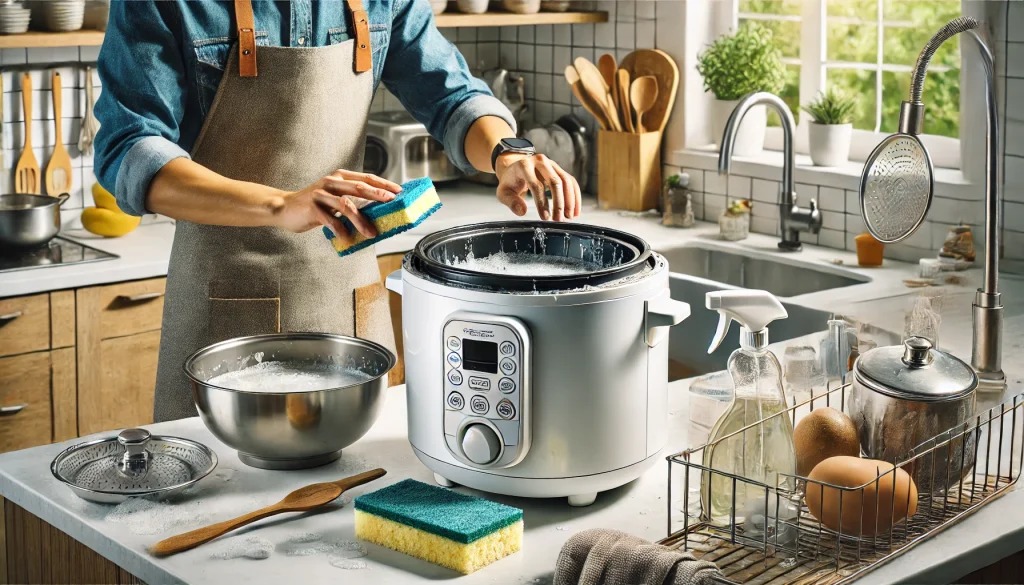As an Amazon Associate I earn from qualifying purchases.
Keeping your rice cooker clean isn’t just about hygiene; it’s essential for maintaining its performance and longevity. Whether it’s the starchy build-up after a few uses or the occasional burnt grains at the bottom, knowing how to clean a rice cookers properly can make your kitchen routine smoother and your meals tastier. In this guide, we’ll walk you through the step-by-step process to ensure your rice cooker remains in pristine condition, ready to whip up your next delicious meal.
Importance Of Keeping Your Rice Cooker Clean
Keeping your rice cooker clean is crucial for several reasons, both for the quality of your meals and the longevity of the appliance:
- Food Safety: Leftover rice can harbor bacteria, including Bacillus cereus, which can cause food poisoning. Regular cleaning prevents the growth of these bacteria.
- Taste and Quality of Rice: Residual starch and old rice grains can stick to the pot and affect the flavor and texture of fresh rice. A clean cooker ensures that every batch tastes as it should.
- Efficiency and Performance: Buildup can interfere with the cooker’s sensors and heating elements, leading to uneven cooking and longer cooking times. Keeping it clean ensures it operates efficiently.
- Prevent Cross-Contamination: If you use your rice cooker for different types of grains or flavored rice, not cleaning it can lead to flavor transfer, affecting the taste of subsequent dishes.
- Appliance Longevity: Regular maintenance, including cleaning, extends the life of your rice cooker. Accumulated grime can cause physical damage over time, potentially leading to the need for repairs or replacement.
- Aesthetics and Hygiene: A clean rice cooker is more appealing and hygienic to use. It reflects well on your overall kitchen cleanliness and upkeep.
Regular cleaning is a simple yet effective way to ensure your rice cooker remains a reliable and hygienic tool in your culinary arsenal.
Overview Of Cleaning Frequency And Basic Care
To ensure your rice cooker remains in optimal condition, adhering to a regular cleaning schedule and following basic care guidelines is important. Here’s a general overview:
Cleaning Frequency
- After Every Use: Wipe the inner cooking pot with warm soapy water and a soft sponge to remove any leftover rice and starch. Rinse and dry thoroughly before replacing it in the cooker.
- Weekly or Bi-weekly: Depending on use, give the entire rice cooker, including the lid, inner pot, and heating plate, a thorough clean. If you use it daily, consider a weekly cleaning routine.
- Monthly: Deep clean the rice cooker, focusing on areas like the steam vent, condensation collector, and inner lid if they are detachable. These parts can harbor residue that might not be visible but can affect performance and hygiene.
Basic Care Tips
- Use the Right Utensils: Always use wooden or plastic utensils to remove rice or stir in the pot to prevent scratching the non-stick surface.
- Avoid Harsh Cleaners: Stick to mild detergents and avoid abrasive sponges or scouring pads. For tough stains, soaking the pot in warm soapy water usually helps.
- Dry Thoroughly: After washing, make sure all components are completely dry before reassembling to prevent any mildew or odors.
- Store Properly: Ensure the cooker is dry and clean before storing, and place it in a dry area to avoid any moisture build-up.
- Handle With Care: Be gentle with all parts of the rice cooker, especially detachable ones like the inner lid and steam cap, which can be delicate.
By maintaining a consistent cleaning routine and treating your rice cooker with care, you can extend its life and ensure it continues to perform well, making perfect rice every time.
Identifying Your Rice Cooker Type
Identifying the type of rice cooker you have is crucial for understanding the best way to clean it properly. Here’s how to identify your rice cooker type and some cleaning tips for each:
1. Standard Rice Cookers
These are the most common types, often featuring a simple one-button operation.
- Cleaning Tips: After each use, wash the removable inner pot with warm, soapy water. Wipe down the exterior and the lid with a damp cloth. Check if the heating element is free of any rice grains or residue.
2. Microwave Rice Cookers
These are plastic containers designed for cooking rice in a microwave.
- Cleaning Tips: Microwave rice cookers are usually dishwasher safe. If washing by hand, use a sponge with dish soap and rinse thoroughly. Dry before next use.
3. Induction Heat Rice Cookers
These use magnetic fields to heat the cooking pot directly, providing more precise temperature control.
- Cleaning Tips: The inner cooking pot can often be removed and washed like any other rice cooker. For the base and sensors, use a soft, damp cloth to avoid damaging the induction elements.
4. Pressure Rice Cookers
These cookers use pressure to speed up the cooking process, resulting in quicker meal preparation.
- Cleaning Tips: Remove the inner pot and wash it separately. Make sure to clean the rubber gasket, valve, and lid under running water. Handle the pressure seal and valve carefully as they are integral for safe operation.
5. Multi-Functional Rice Cookers
These are versatile kitchen appliances that can cook rice and perform functions like steaming, slow cooking, and more.
- Cleaning Tips: Due to the variety of functions, ensure that all additional components such as steam trays and measuring cups are cleaned regularly. Check the user manual for specific instructions on how to clean sensors or digital panels.
General Tips for All Types:
- Always disconnect the rice cooker from power before cleaning.
- Never immerse the electrical base, control panel, or heating element in water.
- Use non-abrasive cleaners and tools to prevent scratching or damaging surfaces.
By understanding your rice cooker type, you can adopt the most effective and safe cleaning methods to keep it functioning well and extending its lifespan.
Daily Cleaning Steps
Cleaning your rice cooker daily is an excellent habit to maintain its functionality and hygiene. Here are the daily cleaning steps for a standard rice cooker:
1. Unplug the Rice Cooker
Always ensure the appliance is turned off and unplugged before cleaning to avoid any electrical hazards.
2. Allow to Cool
Give the rice cooker some time to cool down completely after use before you begin cleaning.
3. Remove Inner Pot and Accessories
Take out the removable inner cooking pot, along with any utensils, measuring cups, or steam trays that were used.
4. Wash the Inner Pot
Wash the inner pot with warm soapy water using a soft sponge or cloth. Avoid using abrasive scrubbers as they can damage non-stick surfaces. Rinse well and dry thoroughly.
5. Wipe the Heating Plate
Using a damp cloth, gently wipe the heating plate to remove any spilled grains or residue. Ensure that it’s completely dry before replacing the pot.
6. Clean the Lid and Steam Vent
Wipe the lid and any vents with a damp cloth. Some models have removable lids or steam caps that can be washed separately under running water.
7. Dry and Reassemble
Make sure all parts are completely dry before reassembling the rice cooker. This prevents mildew or odors from developing.
8. Wipe the Exterior
Use a damp cloth to wipe the exterior of the rice cooker, including the control panel. Avoid using harsh chemicals or too much water, which could seep into the electronics.
9. Store Properly
Once cleaned and dried, store your rice cooker in a dry place until next use. Ensure it’s covered to protect from dust.
Regular daily cleaning will not only prolong the life of your rice cooker but also ensure that your rice always tastes fresh and is safe to eat. For more specific or deep cleaning requirements, refer to your rice cooker’s user manual.
Deep Cleaning Routine
For a thorough deep cleaning of your rice cooker, which is recommended once a month or more frequently depending on use, follow these detailed steps. This process helps address stubborn residues and maintain the appliance in optimal condition.
1. Unplug and Cool Down
Ensure the rice cooker is unplugged and completely cooled before you begin the deep cleaning process.
2. Disassemble Removable Parts
Take apart all removable components, including the inner cooking pot, steam tray, inner lid (if detachable), and any other accessories.
3. Soak and Scrub the Inner Pot
Fill the inner pot with hot water and a few drops of dish soap. Let it soak for 20-30 minutes to loosen any stuck-on food or starch residue. After soaking, use a non-abrasive sponge or brush to scrub the pot gently. Rinse thoroughly with clean water.
4. Clean the Lid and Steam Vent
If your cooker’s lid and steam vent are detachable, soak and scrub them as well. Pay special attention to the steam vent as it can accumulate a lot of residue. Use a small brush or toothpick to clear out any blocked vents.
5. Wipe the Heating Element and Sensors
Carefully wipe the heating plate and any exposed sensors with a soft, damp cloth. Avoid using abrasive materials or too much water, which could damage the components.
6. Clean the Outer Surfaces
Wipe the exterior of the rice cooker, including the control panel, with a damp cloth. You can use a mild cleaner if there are any greasy spots or fingerprints. Ensure no moisture enters the electrical components.
7. Dry Thoroughly
Make sure all parts are completely dry before reassembling the rice cooker. This is crucial to prevent rusting of metal parts and growth of bacteria or mold.
8. Reassemble and Store
Once every component is dry, reassemble the rice cooker. Ensure everything is securely in place to avoid operational issues.
9. Run a ‘Water Only’ Cycle
After reassembling, it’s a good practice to run one cycle with just water. This helps ensure that any residual cleaner is removed and that the appliance is ready for cooking.
By following this deep cleaning routine regularly, you ensure that your rice cooker remains in good working condition, prolonging its lifespan and maintaining the quality of the food it prepares.
Dealing With Tough Stains And Odors
Dealing with tough stains and odors in your rice cooker can be challenging, but with the right approach, you can keep it looking and smelling fresh. Here’s a step-by-step guide to tackle these common issues effectively:
1. Vinegar and Water Solution
Mix a solution of equal parts white vinegar and water. Vinegar is a natural descaler and deodorizer that can help break down food residues and combat odors without harming the surfaces of your cooker.
2. Run a Cleaning Cycle
Fill the inner pot with the vinegar solution up to the normal water level you’d use for cooking rice. Turn on the rice cooker and let it complete a cooking cycle. The heat combined with the vinegar will help loosen and lift the stains and eliminate odors.
3. Let It Soak
After the cycle is complete, let the vinegar solution sit in the pot for an hour or more to soften any stubborn stains further and neutralize odors.
4. Scrub Gently
Once the soaking is complete, discard the vinegar solution and use a soft sponge or cloth to scrub the interior gently. For non-stick surfaces, ensure you use a non-abrasive sponge to avoid scratches.
5. Baking Soda for Stubborn Stains
If stains persist, make a paste using baking soda and a small amount of water. Apply this paste directly to the stained areas and let it sit for 15 to 30 minutes before scrubbing gently. Baking soda is mildly abrasive and helps in removing tough stains without damaging surfaces.
6. Clean and Rinse
Wash the pot and any other treated parts with warm, soapy water to remove any cleaning residue. Rinse thoroughly with clean water.
7. Dry Thoroughly
Ensure all components are completely dry before reassembling to prevent any mildew or rust from forming.
8. Freshen with Lemon
For a fresh scent and additional antibacterial action, rub a slice of lemon around the inner pot and lid after cleaning or add a few lemon slices to the pot and fill it with hot water. Let it sit for an hour, then rinse and dry.
9. Regular Maintenance
Prevent future stains and odors by ensuring your rice cooker is cleaned regularly and thoroughly dried after each use. Regular cleaning prevents the buildup that can lead to tough stains and lingering odors.
By incorporating these steps into your cleaning routine, you can maintain a clean, fresh-smelling rice cooker, enhancing both the performance of your appliance and the taste of your rice.
Maintaining The Exterior Of The Rice Cooker
Maintaining the exterior of your rice cooker not only keeps it looking good but also helps extend its lifespan by preventing build-up that can interfere with its functions. Here are some practical tips for keeping the outside of your rice cooker clean and in great condition:
1. Regular Wiping
After each use, once the cooker has cooled down, wipe the exterior with a clean, damp cloth. This removes any spills, splatters, or fingerprints and prevents them from becoming hardened over time.
2. Use Mild Detergent
If the exterior is particularly greasy or dirty, use a mild detergent mixed with water. Apply this solution with a soft cloth, gently rubbing the dirty areas. Avoid harsh chemicals and abrasive cleaners that can damage the finish of your rice cooker.
3. Dry Thoroughly
After cleaning, it’s essential to dry the exterior thoroughly with a soft, dry cloth. This prevents water spots and streaks, keeping the surface shiny and new-looking.
4. Polish Stainless Steel Exteriors
If your rice cooker has a stainless steel exterior, you can use a specialized stainless steel cleaner or a DIY solution of vinegar and water to polish it. Apply the cleaner and buff with a dry cloth to bring out the shine.
5. Handle with Care
When moving your rice cooker, be sure to handle it gently to avoid dents and scratches. These can not only mar the appearance but also expose underlying materials to damage and corrosion.
6. Avoid Moisture Build-up
Ensure that the area around your rice cooker is well-ventilated to avoid moisture build-up, which can lead to rust or electrical issues. Moisture can be particularly problematic in areas where the cooker’s vents are located.
7. Regular Inspections
Periodically check the condition of the power cord and the area around the heating element. Clean off any dust or grime to ensure good electrical contact and to prevent fire hazards.
8. Protect When Not in Use
If you do not use your rice cooker frequently, consider covering it with a breathable cloth or storing it in a cupboard to protect it from dust and kitchen grease.
By following these steps, you can keep the exterior of your rice cooker clean and well-maintained, ensuring it remains a functional and attractive part of your kitchen for years to come.
Troubleshooting Common Issues
Troubleshooting common issues with your rice cooker can help you maintain its performance and extend its lifespan. Here’s a guide to identifying and resolving some typical problems:
1. Rice Cooker Not Starting
- Check Power Supply: Ensure the cooker is plugged in and the outlet is functioning. Try a different outlet if necessary.
- Inspect the Cord: Look for any damage to the power cord. If it appears frayed or worn, it may need replacing.
- Safety Features: Some rice cookers have safety features that prevent them from starting if the lid isn’t closed properly or the inner pot isn’t placed correctly. Ensure all parts are correctly aligned and secured.
2. Rice Not Cooked Properly
- Water-to-Rice Ratio: Double-check that you’re using the correct water-to-rice ratio. Different types of rice require different amounts of water.
- Even Distribution: Ensure the rice is spread evenly in the pot. Uneven layers can result in improperly cooked rice.
- Lid Seal: If the lid isn’t sealing properly, steam can escape, affecting the cooking. Make sure the lid and its gasket are clean and well-fitted.
3. Overcooked or Burnt Rice
- Temperature Sensor: If rice is consistently overcooked or burnt, the temperature sensor might be faulty or obstructed. Clean any residue from the sensor and check if it needs replacing.
- Thermal Fuse: A malfunctioning thermal fuse can cause overheating. This component may need to be replaced if the rice cooker overheats frequently.
4. Undercooked Rice
- Power Interruptions: Check for any interruptions during the cooking cycle. A temporary power cut or the cooker being unplugged can result in undercooked rice.
- Heating Element: Inspect the heating element for any signs of damage or corrosion. A failing heating element can lead to insufficient heating.
5. Strange Noises or Smells
- Calcium Buildup: If your water is hard, calcium buildup might cause noise or a burning smell. Run a cleaning cycle with vinegar or lemon juice to remove deposits.
- Foreign Objects: Ensure there’s nothing stuck around the heating element or inner pot that could be burning.
6. Leaking
- Worn Gaskets: Over time, the seal or gasket on the lid can wear out and cause steam or water to leak. Check the gasket for any cracks or erosion and replace it if necessary.
- Cracks in the Pot: Inspect the inner pot for any cracks. Even small cracks can lead to significant leaks during cooking.
By systematically checking these areas and making appropriate adjustments or replacements, you can often solve common issues without the need for professional repairs. Regular maintenance and proper use according to the manufacturer’s instructions also help in avoiding many of these problems.
Safety Tips for Cleaning Electrical Appliances
When cleaning electrical appliances, safety is paramount. Here are some essential safety tips to keep in mind to ensure you and your appliances stay safe during cleaning:
1. Unplug Before Cleaning
Always unplug the appliance from the electrical outlet before starting any cleaning operation. This eliminates the risk of electric shock and ensures the appliance is safe to handle.
2. Avoid Water Exposure to Electrical Components
Never expose electrical components such as plugs, cords, and switches to water. Use a damp cloth to clean these parts if necessary, but make sure it’s well wrung out to prevent water drips.
3. Use Appropriate Cleaning Agents
Use cleaning agents that are suitable for the appliance’s materials. Avoid harsh chemicals that can damage the appliance’s surfaces or internal components. Mild soapy water is often sufficient for many cleaning tasks.
4. Do Not Submerge
Never submerge electrical appliances in water. Even if the main body of the appliance seems sealed, water can seep into the electrical systems and cause damage or create a hazard.
5. Check for Wear and Tear
Before cleaning, inspect the appliance for any signs of wear and tear, such as frayed cords, cracked housings, or loose components. If you find any damage, it’s safer to have the appliance repaired before using it again.
6. Dry Thoroughly
After cleaning, ensure that the appliance is completely dry before reconnecting it to power. Residual moisture can cause short circuits or electrical faults.
7. Follow Manufacturer’s Instructions
Always refer to the manufacturer’s cleaning instructions for specific advice related to your appliance. This can include guidance on disassembling parts for cleaning or warnings about sensitive areas.
8. Be Cautious with Moving Parts
Be careful when cleaning appliances with sharp or moving parts, such as blenders or food processors. Make sure these are disassembled if possible and cleaned separately to avoid injury.
9. Ventilation
Ensure good ventilation if you need to use any volatile cleaning agents. Some cleaning chemicals can release harmful vapors, especially in enclosed spaces.
10. Reassemble Correctly
After cleaning and before plugging the appliance back in, make sure all components are correctly reassembled and secure. Incorrect assembly can lead to malfunctions or accidents.
By following these safety tips, you can ensure that cleaning your electrical appliances is done safely and effectively, prolonging their life and maintaining their performance.
Frequently Asked Questions (FAQ’s)

Here are some expertly crafted questions and answers that cover various aspects of cleaning a rice cooker, providing comprehensive guidance and tips:
Q: How often should I clean my rice cooker?
A: It’s best to wipe down the inner pot and lid after every use to prevent rice residue from hardening. A more thorough cleaning of all components, including the heating element and outer surfaces, should be done at least once a month, or more frequently depending on usage.
Q: What is the safest way to clean the inner pot of a rice cooker?
A: Use warm, soapy water and a soft sponge or cloth to clean the inner pot. Avoid abrasive scrubs or steel wool, which can scratch non-stick surfaces. For tough stains, let the pot soak in soapy water before scrubbing gently.
Q: Can I put the inner pot and other removable parts in the dishwasher?
A: Check your rice cooker’s manual, as some inner pots, especially those with non-stick coatings, are not dishwasher safe. Components like the steaming tray or measuring cups are often dishwasher safe, but it’s important to verify with the manufacturer’s recommendations.
Q: How do I remove burnt rice from the bottom of the pot?
A: Soak the pot in hot water with a bit of dish soap for a few hours, then use a wooden or plastic spatula to gently scrape off the burnt rice. For persistent stains, a paste of baking soda and water applied directly to the area can help lift the residue.
Q: What is the best method for cleaning the exterior and the control panel of my rice cooker?
A: Wipe the exterior and control panel with a soft, damp cloth. For greasy or sticky spots, use a mild detergent diluted with water. Avoid harsh chemicals and make sure the cloth is not too wet to prevent water from seeping into the electronic components.
Q: How can I deodorize my rice cooker if it starts to smell?
A: Run a cycle with a mixture of water and a few tablespoons of white vinegar or lemon juice, then let it sit for an hour before rinsing. This will help neutralize odors and remove any lingering smells.
Q: Is it necessary to clean the heating element? If so, how should I do it?
A: Yes, it is important to keep the heating element clean to ensure efficient operation. Make sure the cooker is unplugged and completely cool, then wipe the element gently with a dry cloth to remove any debris. Avoid using water or cleaning solutions directly on the heating element.
Q: What precautions should I take when cleaning electrical parts of the rice cooker?
A: Always ensure the rice cooker is unplugged and completely cool before cleaning. Do not immerse the base, cord, or plug in water. Use a slightly damp cloth to wipe down these areas and dry thoroughly.
Q: How should I clean the inner cooking pot?
A: After each use, remove the pot from the rice cooker and wash it with warm soapy water using a soft sponge or cloth. Avoid using abrasive scrubbers as they can damage non-stick coatings. Rinse thoroughly and dry before replacing it in the cooker.
Q: What’s the best way to deal with burnt rice at the bottom of the pot?
A: Soak the inner pot in warm water with a little dish soap to loosen the burnt rice. After soaking for 30 minutes to an hour, use a plastic or wooden spatula to gently scrape off the residue. Avoid metal utensils as they can scratch the surface.
Q: Can the inner pot and accessories be cleaned in the dishwasher?
A: Check your manufacturer’s instructions to confirm if the parts are dishwasher-safe. Generally, stainless steel pots can be placed in the dishwasher, but non-stick coated pots should be washed by hand to avoid damaging the surface.
Q: How do I clean the heating plate and other non-removable parts?
A: Ensure the rice cooker is unplugged and completely cool. Wipe the heating plate and other surfaces with a damp cloth. For stubborn stains or build-up, use a mild detergent diluted with water and a soft cloth. Make sure to dry thoroughly afterward.
Q: Is it necessary to clean the steam vent and how?
A: Yes, cleaning the steam vent is crucial as it can collect food particles and residue. Detach the vent if possible and soak it in soapy water, then use a small brush or cloth to clean inside thoroughly. Rinse well and dry before reassembling.
Q: How can I eliminate odors from my rice cooker?
A: To deodorize your rice cooker, fill the pot with a mixture of water and a few tablespoons of baking soda or vinegar. Run a normal cooking cycle without rice, then let it sit with the lid open for a few hours. Rinse and dry thoroughly.
Q: What should I use to clean the exterior of the rice cooker?
A: Wipe the exterior with a soft, damp cloth. For greasy or sticky areas, you can use a mild solution of dish soap and water. Avoid harsh chemicals and abrasive cleaners that can damage the finish.
Q: How often should I deep clean my rice cooker?
A: It depends on how frequently you use it. A good rule of thumb is to deep clean your rice cooker once a month or more if you use it frequently or for different types of food besides rice.
These questions and answers provide valuable insights into the proper care and maintenance of your rice cooker, helping you keep it in top working condition for years.
Conclusion
In conclusion, maintaining a clean rice cooker is essential not just for the taste and quality of your rice, but also for the longevity and efficiency of your appliance. By following the simple yet effective steps outlined in this guide on how to clean a rice cooker, you can ensure that your device remains a reliable partner in your culinary adventures. Regular cleaning prevents buildup, preserves the non-stick surfaces, and ensures optimal performance, making each batch of rice perfect. Remember, a well-maintained rice cooker is the secret to effortless and delicious meals, proving that sometimes, it’s the cleanest tools that produce the tastiest results. Keep your rice cooker sparkling, and it will continue to serve up the perfect foundation for a myriad of dishes for years to come.






